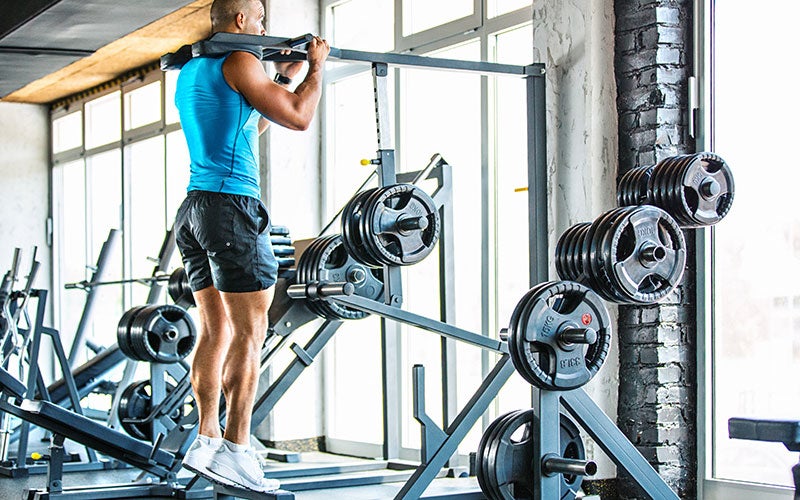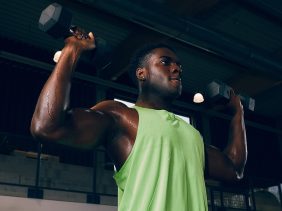7 Exercises to Boost Calf Muscle Strength
 @gilaxia
@gilaxia
Planning a lower body workout? It’s fair to assume you’ve got squats on the mind. And for good reason. Your glutes are the biggest muscle in the body. But there’s another set of leg muscles that need some TLC — the calves. These muscles are required for cycling, sprinting, jumping, swimming, and agility work. The calves also stabilize your knees and Achilles’ tendons which protects you from injuries. So why not devote some moves to these under-appreciated muscles. And we’ll show you how.
Calf muscles, at a glance
The calf muscles are located on the back of the lower legs, between the back of the knee crease and heels. There are two layers: superficial and a deep muscle. Their main task is to flex the foot or toes towards the sole of the foot (plantar flexion). Plus, they’re great at keeping you upright and stable when you walk, run or jump. Have you ever stepped in a funny way and your leg caved in a little, only to right itself? That’s your calves getting activated, since they are involved in the internal and external rotation of the feet.
One thing to know is that strengthening your calves isn’t as straightforward as, say, your glutes. It’s not like you’re going to be seeing the numbers you’re lifting climb steadily. Think of this as accessory work that is essential to everything else you do in the gym—and the rest of your life.
And if you’re a cyclist, you really need strong calves. Consider that triathletes are taught to use their calves primarily when they’re on the bike, exerting the most energy when they pull up on the pedal to save their hamstrings from the run portion of the race. And if you’re prone to knee or Achilles’ injuries, getting the calves in ship shape will help keep you off the DL during activities like a plyometric workout or classic weight training.
Related: What are your goals? Take our Body Check here!
The workout
Train your calves once or twice a week, during a day you’re already working out your lower body. Pick two of the following exercises and do 3 to 4 sets of 15 to 20 reps. If this type of training is new to you, start with fewer sets or reps, so you don’t strain your calves. To avoid calf cramps, start with a light or no-weight warm-up set at a time.
1) Calf raises
Stand with feet slightly narrower than hip-width apart on a stair or step on the balls of your feet, heels over the edge, arms at sides, to start. Activate core and glutes, keep lower back neutral, and raise heels as much as possible, then lower them as much as possible, for one rep. Do all reps and rest as long as you need. If balance is an issue, rest fingertips on a wall or railing. If this is too easy, challenge yourself by holding light to medium dumbbells.
These supplements will help keep your body on tip-top form.
2) Seated calf raises
Sit in a chair or on an exercise bench, a barbell or dumbbells resting on your thighs just above your knees, legs at a 90° angle, to start. Engage core and glutes to stay tall and still, and lift heels as high as possible, then lower to start, for one rep. Increase weight slowly to avoid cramps or injury. This can also be done with a resistance band anchored on either side of legs around heavy dumbbells.
3) Squats with lifted heels
Start with feet slightly wider than hip-width apart, a thin weight plate under each heel, balls of feet on floor. Tighten core, engage glutes, and perform a bodyweight squat for one rep. Only add weight if you can perform this with perfect balance, and go up slowly.
Refuel: Try our whey protein either before or after exercising.
4) Squat jumps
Stand with feet slightly wider than hip width apart. Start by dropping into a squat, then press hard through balls of feet, swing arms toward ceiling, and explosively jump up, pointing toes at the apex of the jump, then land softly and return to start for one rep. Jump continuously.
5) Lunges with calf raise
Start with feet hip-width apart. Step take a big step forward with left leg and drop right knee toward ground so left leg creates a 90° angle. Maintaining a tight core, lift left heel off floor, then press through left foot and return to start. Repeat on right side. That’s one rep. If that’s too intense on your knees, do reverse squats.
Related: If you hate squats, these exercises are just as efficient
6) Jumping lunges
Stand with feet hip width apart, and step left leg forward, dropping right knee toward ground so that left knee is in front of left ankle slightly, to start. Push off balls of feet and explosively jump up, swapping leg positions in midair and landing softly. Jump again to return to start. That’s one rep.
7) Jump rope
All variations of jumping rope help work your calves.
More healthy living tips from foodspring:
- Weight Loss Workout Plan: What you need to know
- How to Lose Weight with Yoga
- How to lose weight without dieting: 13 tips to your feel-good body
- Create your ideal weight loss meal plan and work towards your feel-good body!
- Weight Lifting For Weight Loss
Sources for this article
We at foodspring use only high-quality sources, including peer-reviewed studies, to support the facts within our articles. Read our editorial policy to learn more about how we fact-check and keep our content accurate, reliable, and trustworthy.





























